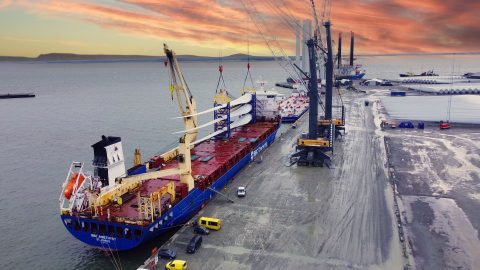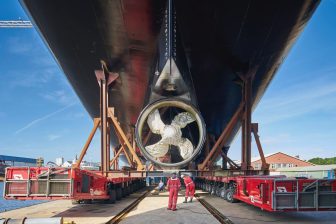
Finally, a green trajectory for shipping
Opinion piece by Felix Klann, Junior Shipping Policy Analyst at Transport & Environment
Responsible for about 3 per cent of global carbon emissions, maritime shipping has long been left off the hook for climate action. This is particularly troubling as the industry has shown no sign of reducing emissions. 2022 was a record year for shipping pollution and emissions show no sign of slowing down.
But all of this is set to change with new European rules for the sector. In this blog post, Transport & Environment sets out what the European Union has put in place, what it means for shipping companies and what the missing piece of the puzzle is.
What exactly are we talking about?
The European Green Deal is the European Commission’s plan to drastically reduce pollution in the EU. It includes a number of measures to rein in pollution from the shipping sector. Overall, the Commission’s legislative puzzle includes rules for all key stakeholders – ports, shipowners and fuel providers – ensuring that everyone knows the role to play in shipping’s green transition.
From 2024, shipowners must pay for their pollution in the EU’s carbon market, the Emission Trading System (ETS). The ETS requires polluters to purchase pollution rights (known as EU emission allowances or EUAs) for every tonne of greenhouse gas (GHG) they emit each year or face penalties. The system covers Europe’s share of international emissions. That means shipping companies will have to pay for all their pollution on voyages between European ports and half of the emissions from voyages between European and non-European ports. This leaves the door open for the relevant non-European country to charge for its share of the international voyage.
But how exactly will the ETS contribute to shipping’s green transition? While the new law will contribute to narrowing the price gap between fossil fuels and their sustainable counterparts, it will not bridge it. This is why the revenue generated through the ETS is important. While most of it will go to national budgets to go to public services, the European Commission earmarked around €1.8 billion to be reinvested into shipping’s green transition.
Read also: UECCs formula for EU ETS
Even so, the ETS alone will not be enough to transition the sector away from polluting fuels, so bespoke laws are needed to force shipping companies to go green on fuels. This is where the second piece of the puzzle, FuelEU Maritime (FEUM) comes in. Starting in 2025, shipping companies will have to gradually switch to greener fuels and, from 2030, certain ship types like ferries and containerships will have to plug into shoreside electricity (SSE) in ports.
What’s more, the law has a number of requirements to make sure the right fuels are used by the shipping industry. First of all, the regulation calculates the emissions of fuels throughout their whole lifetime – from the well to the ship’s wake (well-to-wake) in the jargon. This means that if a shipping company uses hydrogen made from natural gas, it will still have to pay for the emissions related to the natural gas even though hydrogen as a fuel does not produce emissions when used in a ship.
Secondly, there is a clause stating that 2 per cent of the share of marine fuels used in EU shipping in 2034 should be green hydrogen or its derivatives (like e-ammonia or e-methanol). These so-called renewable fuels of non-biological origin (RFNBOs) are the only sustainable and scalable options for the maritime sector, hence the European Commission has put in this specific provision to ensure demand for them. So, do all ships covered under FEUM need to transition to green fuels now? The short answer is no. The regulation allows a certain degree of flexibility. For example, shipowners can ‘pool’ compliance across vessels and even with other companies. This means that one overachieving company can in effect sell compliance credits to a company that hasn’t invested in green fuels.
Similarly, a company that overachieves the target can ‘bank’ compliance credits to be used in the following years. Or, a company can ‘borrow’ compliance credits from future years if it believes it will not achieve the targets in one year.
Completing the Puzzle
The last piece of the puzzle is the supply of green fuels. This is where the Renewable Energy Directive (RED) comes in. This law mandates the amount of renewable energy that should be supplied in each European country. In order to promote the uptake of green fuels – RFNBOs – in shipping, the law sets a target of 1.2% as the share of energy supplied in each country to the shipping sector that should be RFNBOs. This of course only applies to countries with maritime ports.
It is up to EU countries to make sure the target is met. Here there is a clear need for European nations to step up and take clear measures to ensure that green fuels – RFNBOs – go where they’re needed. As the European shipping industry has made clear, that means to shipping and not to road transport.
A price tag for sustainability
So, shipping companies will (finally) have to pull their weight! Mandates to use green fuels, emission trading, and investments in new or retrofitted vessels – the new rules introduce new costs and pressures to maritime commercial shipping. Won’t this change the face of the shipping industry as we know it? The answer is a clear no.
T&E has looked into the depth of the new laws and found that the added cost to the final products will be next to nothing. To ship a pair of trainers on a completely green ship would add just 8 cents. Not exactly breaking the bank!
Read also: AAL takes the EU ETS Surcharge route
Shipping companies have recently confirmed that they will pass on the costs related to the ETS rather than reduce their activity or significantly change their behaviour.
In the long run, economies of scale and increased production of green fuels will decrease the costs. Still, some rise in operational costs is expected. As the shipping sector has long profited from using exceptionally cheap fossil fuels and little oversight, this represents the industry catching up to other modes of transport. But luckily the industry will be able to pass on the costs to you and me. And the only changes we will notice are cleaner seas and air.
Steaming ahead towards a clean shipping industry
It is therefore safe to say that no one will suffer from these new policies. But the last piece of the puzzle – the availability of green fuels – needs to be ensured by European countries. They can do this by adopting clear and ambitious targets for energy producers on the supply of RFNBOs to the maritime sector. At a minimum, this should include a robust 1.2 per cent target for RFNBOs as the last piece of shipping’s green puzzle. They can – and should – ensure e-fuels for the right markets where no viable alternatives are currently available, namely for shipping.
It is high time for maritime shipping to pull its weight, and for legislators and fuel producers to enable them to do so.
You just read one of our premium articles free of charge
Register now to keep reading premium articles.




